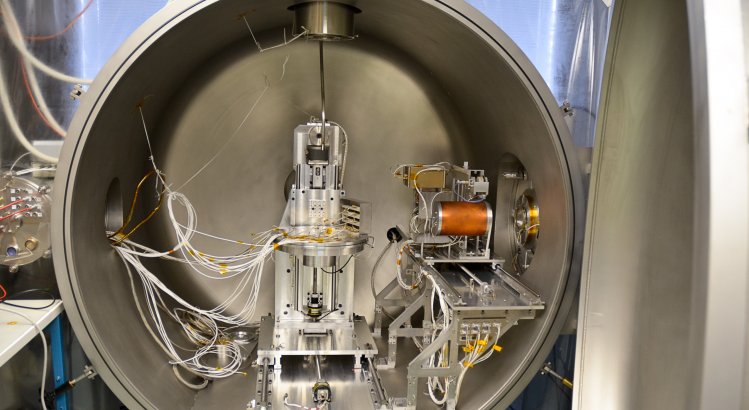
Calibration Facility
Technical specifications
The IRF calibration facility is located in a clean tent within a larger laboratory and provides all conditions needed to calibrate space plasma instrumentation.
| Chamber dimension | 1.8 m diameter |
| Beam energy Electrons Energetic neutral atoms Ions |
50 eV to 50 keV < 3 keV, H, He, N, O Duo-plasmatron source, 20 eV/q to 50 keV/q |
| Ion optics |
Wien filter for mass separation, max 80 mm beam diameter, >100 nA beam intensity, electrostatic analyser for X- ray suppression. Surface ionisation of the ion beam. |
| Pressure | Down to 10-7 mbar |
| Temperature | Room temperature |
| Read-out / Logging | Customized control and logging system allowing advance motions patterns. |
The table has weight limitations, for further information please contact us with the dimensions of your test object.
Ion source
The system is equipped with an ion source (Peabody Scientific, model P/N B00404), with a platinum gauze filament coated with Barium-carbonate solution to maximise electron emission.
The source can be fed with pure O2, H2 or He to maximise the beam current of these species. Otherwise residual gas is sufficient for a N-beam, for example. The ion beam enters the test chamber horizontally.
A Faraday cup inside the chamber provides beam current measurements, necessary for accurate calibration procedures. A beam scanner allows to measure the detailed profile of the beam. When the ion beam is in use, a proxy beam current measurement allows to follow variations in the beam intensity without blocking the beam.
For the calibration of neutral particle instruments, a beam neutraliser can be placed into the ion beam. Ions are converted into neutrals by scattering on a highly polished tungsten crystal surface.
Electron source
The system is equipped with an electron source. The electron beam enters the test chamber vertically from above and intersects with the ion beam axis. The beam characteristics are similar to the ion beam.
UV source
There is one deuterium UV lamp available, which can be integrated into the calibration tank, and produced Lyman-alpha radiation with 121 nm wavelength. The radiator area is 1 cm2 and capable of producing fluxes similar to the Sun’s. It is a fixed lamp.
Turn table for item under test
The chamber is equipped with a 4-axis of freedom turn table (two translational and two rotational axes) to allow positioning and rotation of the item under test relative to the incident electron, ion or neutral beam.
Control system
The computerized control system allows to scale over arbitrary patterns in angular and translational coordinates, suitable for advanced calibration procedures. During the measurements all system parameters are logged.
With these features the IRF calibration facility allows determining various parameters for calibrating space plasma instrumentation, like the angular sensitivity and resolution (polar and azimuthal), detection efficiency, particle energy and particle species dependent factors.
Further reading: www.issibern.ch/PDF-Files/SR-007.pdf page 464
Photos: Annelie Klint Nilsson, IRF
